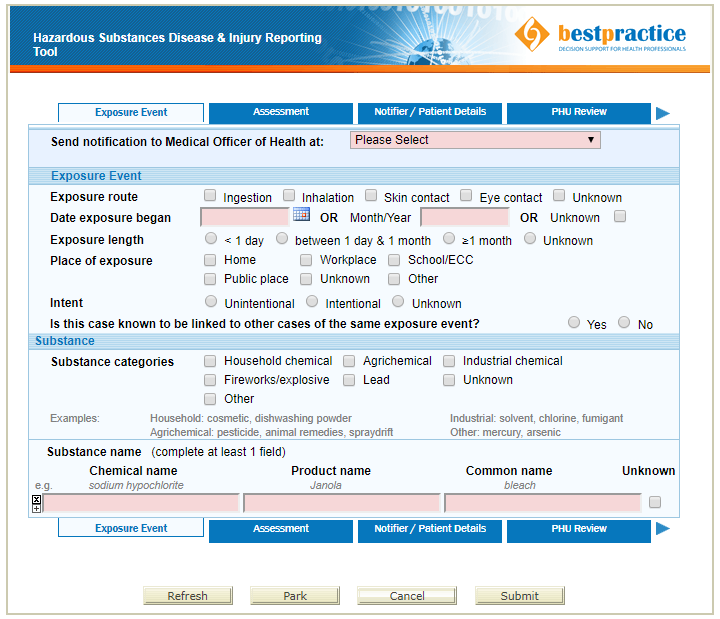About hazardous substances and health
This section provides information about hazardous substances, how they affect our health, and monitoring of hazardous substances injuries and deaths in Aotearoa New Zealand.
On this page:
What is a hazardous substance?
Most people use hazardous substances every day at home and at work. We are broadly familiar with the risk they pose, such as:
- methylated spirits or petrol burn
- bleach is corrosive and can damage the skin
- some garden chemicals are toxic
- fireworks are explosive.
Hazardous substances are commonly also called chemicals. Strictly speaking, hazardous substances are those chemicals that can cause specific types of hazard. According to the Hazardous Substances and New Organisms Act 1996 (HSNO Act), a substance is hazardous if it can:
- explode
- catch fire
- oxidise
- corrode
- be toxic to humans
- ecotoxic.
Hazardous substances can have more than one hazardous property. For example, methylated spirits and petrol are both toxic and flammable. A substance is also considered hazardous if it generates a substance with any or more of these hazardous properties when it comes into contact with air or water.
Some substances are excluded from the HSNO Act, such as medicines in fixed-dose form, alcohol, drugs, food, and carbon monoxide where the source was not from the combustion of gas from a cylinder.
Potential exposures from hazardous substances
Exposure to hazardous substances can occur through various pathways, including:
- breathing in contaminated air and dust
- ingesting contaminated water and food
- skin exposure to chemicals
- fetal exposure during pregnancy.
We can be exposed to a variety of contaminants in our environment. Sources of contaminants include:
- the air we breathe
- toxic substances in the home, including common household products, pesticides, building materials and furnishings
- contaminated soil or buildings
- the workplace.
Hazardous substances diseases and injuries
Hazardous substances can cause considerable harm. Some hazardous substances have only minor effects, while others can have serious consequences.
Symptoms and severity vary widely from case to case.
Hazardous substances diseases and injuries include:
- ingestion of cleaning products or cosmetics by children
- skin contact, ingestion or inhalation of agrichemicals
- carbon monoxide poisoning
- illness caused by exposure to solvents or chlorine
- contact dermatitis due to chemicals
- a fireworks burn or eye injury
- “huffing” (inhaling) of butane.
Hazardous substances are not of equal concern. Toxic effects will vary according to who is exposed and route of exposure. The risk associated with exposure to a hazardous substance is a combination of:
- the amount of the substance (the dose)
- how long people were exposed to it (duration of exposure)
- the toxicity or other hazardous properties
- susceptibility of the people being exposed (e.g. child or adult)
- the likelihood of people being exposed.
Who is more at risk?
Some people are more at risk of disease and injuries from hazardous substances. Population groups most affected include:
- children under five years old – due to their small size, inquisitive nature, and lack of safety awareness
- people who handle chemicals in the workplace.
Legislation to protect people and the environment
Hazardous substances have the potential to cause considerable harm. There is legislation which aims to protect both people and the environment from harm.
Under New Zealand legislation, the following conditions are notifiable to the local Medical Officer of Health:
- Disease and/or injury that a medical professional suspects is caused by a hazardous substance (Hazardous Substances and New Organisms Act 1996)
- Lead absorption equal to or exceeding 0.24 µmol/L (Health Act 1956)
- Poisoning arising from chemical contamination of the environment (Health Act 1956).
The Hazardous Substances and New Organisms Act 1996 (HSNO Act) regulates all substances that are classified as hazardous in New Zealand. It is administered by the Ministry for Environment and implemented by the Environmental Protection Authority.
The Health Act 1956 gives the Ministry of Health the function of improving, promoting and protecting public health.
For more information visit the New Zealand Legislation website.
Surveillance of hazardous substances disease and injury
The Hazardous Substances Surveillance System (HSSS) captures information on injuries caused by hazardous substances. The surveillance system is operated by the Environmental Health Intelligence NZ (EHINZ).
The HSSS incorporates data from a variety of data sources, including the National Minimum Dataset (NMDS), the National Mortality Dataset, the coronial database, and National Poisons Centre calls.
Read the latest statistics about hazardous substances injuries and deaths on the health effects of hazardous substances webpage.
General practitioners (GPs) now also contribute to the surveillance of hazardous substances diseases and injuries.
GPs notify cases of hazardous substances diseases and injuries they see in primary care, through the Hazardous Substances Disease and Injury Reporting Tool (HSDIRT). This electronic form makes primary care notification of diseases and injuries caused by hazardous substances simple and quick (Figure 1). Our team at EHINZ developed the HSDIRT tool, on behalf of the Ministry of Health.
The HSDIRT tool has been available in all areas of New Zealand since 2014. Information collected from the HSDIRT will make an important contribution to hazardous substances surveillance and public health action.
National and health district data will be published annually.
Figure 1: Screenshot of the HSDIRT tool

For more information and resources about HSDIRT, go to the hazardous substances surveillance webpage.

